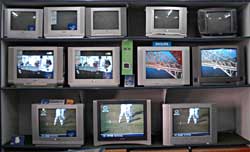 As competition heats up among the six television channels vying for Nepal's advertising pie, the significance of cable operators has suddenly grown by leaps and bounds.
As competition heats up among the six television channels vying for Nepal's advertising pie, the significance of cable operators has suddenly grown by leaps and bounds. Cable television distributors who control distribution in urban areas are being courted by frustrated channel owners. Viewers find it tedious to keep on changing the cable feed at the back of their tv sets, so the cable operators which provide the widest range of channels is ahead of the game. However, the Nepali market is complicated by the fact that the biggest cable operator, Space Time Network (STN) which controls 60 percent of the cable viewership, also owns Channel Nepal, the country's first private TV channel.
Since STN is driving a hard bargain, new private ventures like Kantipur, Nepal One and Image are trying to widen their reach through its smaller competitors. With so many channels, new cable operators have entered the fray
and are trying to wrest a slice of the market.
Although there are 211 registered cable operators across the country, STN's dominance of the urban market has given them a virtual monopoly so far. But a sign of the cable wars to come are already visible: while STN does not carry rival Nepal One and Kantipur, STN's rival Sky Cable retaliated by temporarily taking Channel Nepal off its stream. "We have repeatedly requested STN to carry our channel," says a Nepal One executive here. "We will not give up, we will keep on trying."
Jamim Shah exudes the bravado of a man who knows he dominates the market. But he hints at magnanimity. "We have ordered new equipment. Once we have them, we will see then if we will be able to include the other Nepali channels in our network as well." For now, Shah seems happy to harvest profits to recoup his investment in the the 3,600km of cable infrastructure he has all over the country and his Channel Nepal satellite television venture.
Shah's smugness could be shortlived if non-STN channels all gang up against him, or if Nepal One and Kantipur TV become so popular that his subscribers start demanding that he put them on. For now, the new private channels have no option but to woo small cable operators. Kantipur TV and Nepal One are also working on slick production and smart marketing so that their broadcasts will be hard to pass by.
Nepal One is buying cable connections for its viewers, even if they are already STN subscribers. "We would like them to see our product as well and then decide which one is better," an official with the free-to-air station being broadcast from New Delhi told us.
The past experience of Shangrila Channel is a lesson for new TV stations. When that private venture began airing day TV through state-owned Nepal Television, it failed because cable operators refuse to carry it. "The lesson is that the channels need cable distribution," says Neer Shah who now owns Shangrila wireless distribution through microwave.
The Ministry of Information and Communication has received petitions from operators that the government should ban cable operators from also owning cable distribution, as in India. "We are in the process of discussing if the license laws can be revised," one official told us. But another official in the same ministry told us: "It's a free market, if any other television station wishes to begin a cable business what is the problem?"
The majority of operators want the government to make it mandatory for every cable provider to carry all Nepali channels. "That way, the government itself will earn a big royalty, a big chunk of which is now going to pay foreign channels," says Shah. Already, growing competition among cable operators has brought advantages to viewers. There is a wider range of choice, quality of production has gone up and more Nepalis are spending more time watching Nepali channels than Indian or foreign channels.
Meanwhile, STN is trying to keep its innovative edge by going digital and plans to introduce a cable internet service on its menu to subscribers. If that happens, with a few hardware add-ons and a keyboard, customers can cheaply surf the internet on their television set. Of the nearly two dozen cable operators in the capital, many charge an average of Rs 150 per month, forcing the big boys to revise their rates as well.
The competition among the big players may be cut-throat, but ultimately the Nepali television viewer has benefited from the cable wars.
RELATED ARTICLE
The ratings game >>


